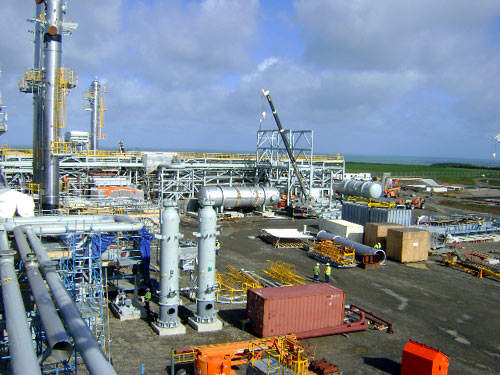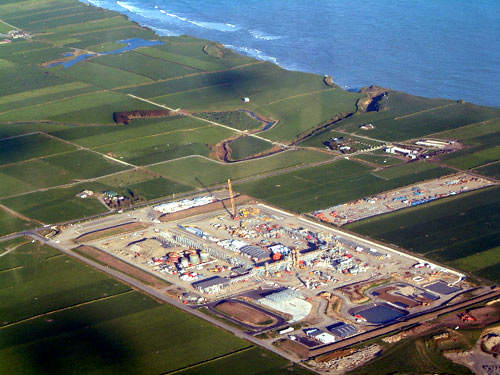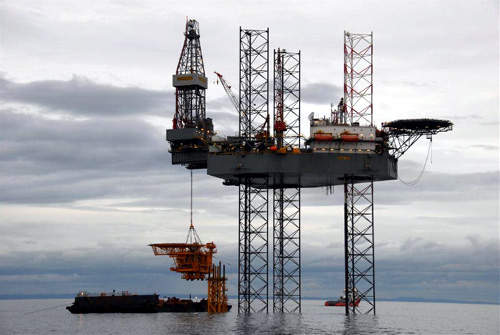New Zealand’s Kupe project is situated within the Kupe Central Field Area (CFA), about 30km offshore south-west of Hawera, in the Taranaki Basin off the North Island, in 35m of water.
The field lies in exploration permit PML 38146, in the same area as the giant Maui gas field, which supplies most of the country’s energy needs.
Kupe oil and gas field
Australian company Origin Energy is developing the field on behalf of joint venture participants Origin Energy Resources (Kupe), which has a 50% interest, Genesis Power with 31%, New Zealand Oil and Gas with 15%, and Mitsui E&P (New Zealand) with 4%.
The discovery well Kupe South-1 (KS-1) was drilled in 1986 and gave 2,000bpd of oil and 5.4mmscf per day of gas. This was followed by the drilling of KS-2 in 1987, and the Kupe South-3 wells and 3a sidetrack (KS-3) in 1988.
KS-2 and the KS-3 both encountered a stratified hydrocarbon reservoir with a significant oil column underlying a thick natural gas column. These three wells formed the basis for the CFA development.
However, the development remained sub-economic because oil prices were low and New Zealand gas prices were very low as a result of the existing arrangements for the sale of gas from the Maui field.
This situation changed as the Maui field started to decline and international oil prices rose. The final investment decision for the development project was made in June 2006, based on an initial budget estimate of NZ$980m ($666m), which was raised by 10% in July 2007.
By June 2008 drilling and testing of the three wells was successfully completed and were suspended pending the completion of the onshore production station.
Production of gas began in December 2009. The project produces about 20 petajoules (PJ) per year of sales gas, with condensate and LPG production reaching 1.7m barrels per year and 90,000t per year, respectively. The project’s lifespan was estimated at between 15 and 20 years.
Geology and reserves
The primary reservoir of the central field area is the paleocene farewell formation. Its reservoir sandstones are predominantly medium to coarse-grained quartz and feldspar, with good porosities and permeabilities, rising to more than 1 darcy permeability in places.
The sandstone members are compositionally immature and feldspar-rich, making them an arkosic to subarkosic sandstone reservoir.
The field’s hydrocarbons were derived from Late Cretaceous to Paleocene, organic-rich, sedimentary source rocks that were thermally cooked in the basin kitchen areas after deep burial, and then migrated updip into the shallower sandstone units within the structural traps.
Recoverable proven and probable reserves for the project are estimated at 254PJ of sales gas, 14.7m barrels of light oil / condensate and 1.1 million tonnes of LPG.
Development of the Kupe field
The Kupe project includes an unmanned offshore platform built above the field production wells and supporting up to six wellheads, a 12in multiphase subsea pipeline to bring the raw gas and liquids to shore, three 50mm subsea utility lines to carry chemicals and other products to the platform, a horizontal directional drilled (HDD) shore crossing to link the offshore and onshore components, an onshore production station, an onshore raw gas pipeline from the HDD site to the production station, and a sales gas pipeline from the production station to the Kapuni gas treatment plant, where natural gas will be injected into the existing transmission network.
The platform consists of a topside deck supported by four legs driven into the seabed. The topside deck contains four levels, including a helideck
The HDD technique was chosen to avoid damage or disturbance to the characteristic cliffs of the Taranaki coastline. It takes the gas pipeline and utility lines underground from 500m inland, under the beach and cliffs and out 1.5km offshore, where they connect to the subsea pipeline and utility lines.
The production station processes the raw gas and light oil from the field to meet sale specifications. A low-pressure flare system is located at ground level for operational control and an elevated flare was installed for emergency use.
A series of wetlands were built to provide a natural cleaning system for stormwater from the site.
The onshore pipeline network involves the installation of a combination of new pipelines and the existing network. New pipelines were required to transfer raw gas the short distance from the HDD shore crossing to the production station (about 300m) and to transfer sales gas from the production station to the Kapuni Gas Treatment Plant (along Inaha and Palmer Road reserves).
A light oil (condensate) pipeline is not a definite component of the project, although it is the preferred method to export the light oil to an existing facility capable of treating it.
In September 2006, Origin awarded the $200m contract for the construction of both the onshore and offshore components of the project to Technip Oceana. Installation of the offshore platform was completed in June 2008.






